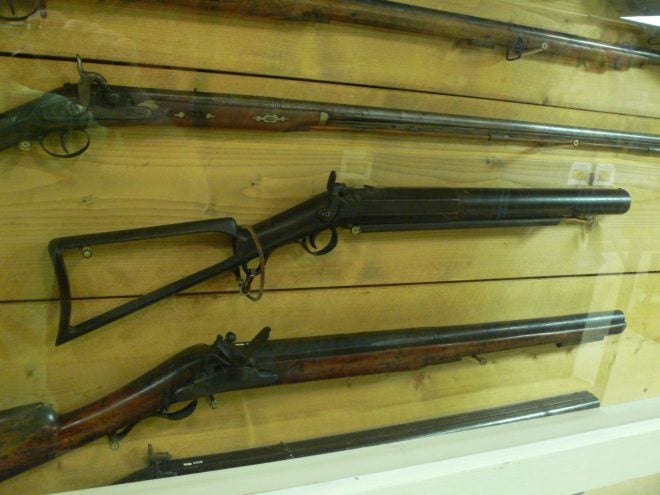Have you ever stood on the bow of a boat floating next to an injured, thrashing whale, harpoon in hand, waiting for the right timing to throw while trying not to die? Well… neither have I. However, by the 1840’s, enough people had, and had had enough. I recently took my family to the Vesterheim National Norwegian-American Museum (http://vesterheim.org/) in Decorah, Iowa and I noticed a strange, but cool looking gun in their firearm display case. There was scant information about it, but what they did say was enough to make me do some additional research. The information sheet said that it was pretty a “Harpoon gun. One-inch-wide bore. May also have been used as a shotgun”. It was clearly a muzzleloader, ignited by a percussion cap.
Editor’s Note: This post was written by TFB fan and friend Doug E. (BattleshipGrey)
whaling Gun and bomb lance
In case you don’t recall, Nicholas C. posted an article in May of last year about a different whaling gun here: https://www.thefirearmblog.com/blog/2017/05/17/greener-whaling-harpoon-gun/ The gun featured in that article was the same style that was used in the movie “Jaws”. However, the gun I’d seen was made around the time “Moby Dick” was published. Although the book probably would’ve been much shorter if Captain Ahab acquired one of these. I discovered that the Brand gun also made an appearance in the 1966 Soviet adventure comedy The Chief of Chukotka. (http://www.imfdb.org/wiki/Chief_of_Chukotka_(Nachalnik_Chukotki),_The)
The gun naturally added the penetrating force needed to get past the whale’s blubber from a safer distance, but it was the harpoon itself that added the extra lethal blow. The harpoons designed with this gun were aptly named “Bomb Lances”.
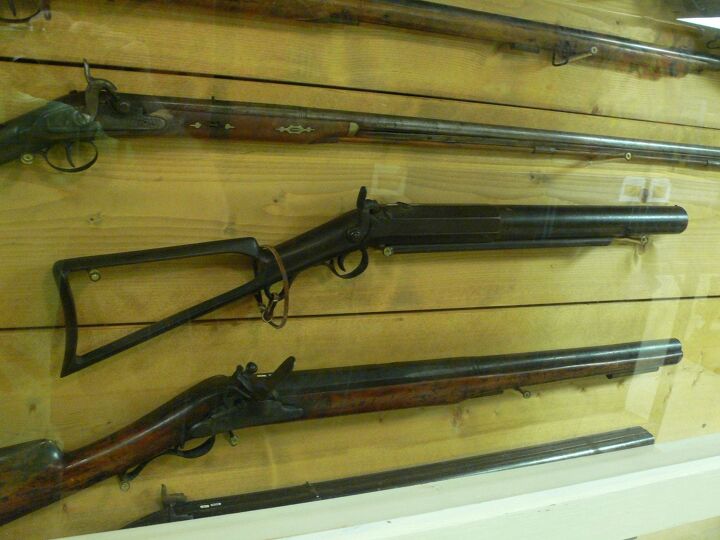
Credit: Doug E.
I apologize for the low-quality pictures. The museum has a rule against using flash photography, so I did my best holding still shooting through the glass.
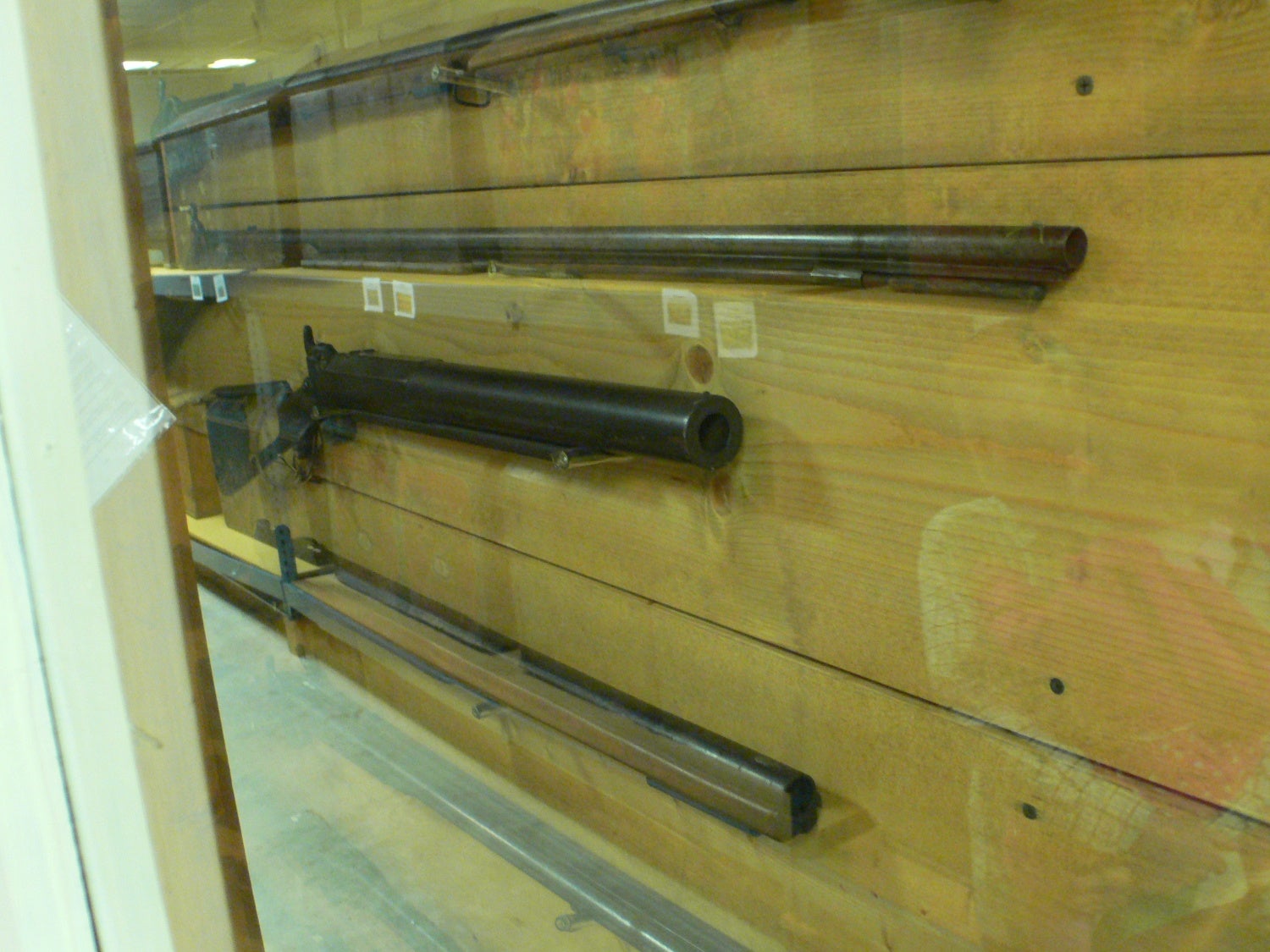
Credit: Doug E.

Wiki commons
There are several websites I found interesting. Antiques of the Sea (http://www.antiquesofthesea.com/whaling.html) appears to have one for sale and one that’s sold. They currently don’t list the price, however, when I first researched it, it was listed at$4,395. Their information stated:
VINTAGE 1850’s “CC BRAND” WHALING HARPOON GUN – USING THE CC BRAND BOMB LANCE
The” CC BRAND HARPOON GUN”, was one of the first and most popular shoulder guns used in the Whaling Industry for many years.
The Gun was made with 3 different standard gun bores, 7/8″, 1 1/8″ and 1 1/4″ sizes to accommodate the different bomb lances Brand made for the whaling needs.
Weight approx: 24 pounds
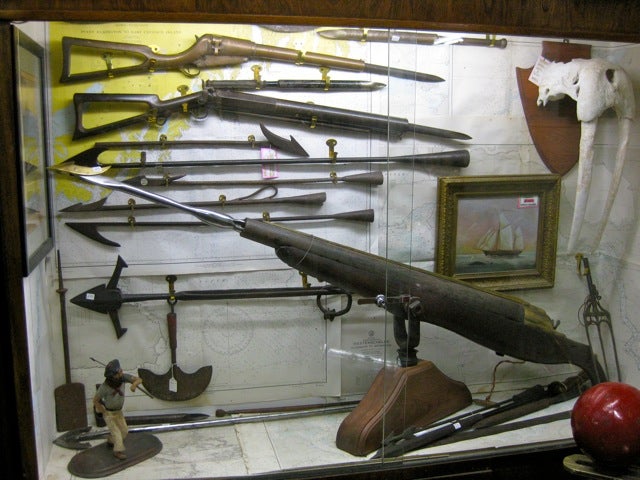
Credit: Antiques Of The Sea
Whalecraft.net (http://www.whalecraft.net/Shoulder_Guns.html#anchor73210) contains lots more information compiled by Thomas G. Lytle. He documents the evolution of the Bomb Lance harpoons used by these guns as well as the different evolutions of the guns themselves (and much more). Mr. Lytle also listed a bit more information about the different sizes available at the time and I’m now curious which model I was looking at in person:
Christopher C. Brand changed the stock from hollow brass to the iron skeleton. From then on the gun has been known as the Brand gun. It was made in three sizes:
#1 had a bore of 7/8″ and weighed approximately 23 lbs.
#2 had a bore of 1-1/8″ and weighed approximately 19-1/2 lbs.
#3 had a bore of 1-1/4″ and weighed 19 lbs. or less.
The various sizes were to accommodate various bomb lances. The #1 gun, with a 7/8″ bore, is the one most used for shoulder gun harpoons.
Also according to Mr. Lytle, the gun was loaded with 3 drams of powder to fire a 3 pound Bomb Lance for an effective range slightly farther than one could throw a hand lance. “How far is that,” you ask? Well, great question. Unlike most internet queries, the answer to this is hidden well, if it was ever written down at all. Of the videos I found on YouTube, it would appear that the idea was to get as close as safely possible to the whale before throwing a harpoon. I’d guess that the average use of a hand-thrown whale iron would be between 0-10 yards. Finding the weight of a hand-thrown iron was also fruitless. Though, in reading more on Mr. Lytle’s site, I tend to think the whole thing weighed about four pounds or less. Before coming to this conclusion, I found the closest object I could find that resembled a hand iron in weight and length. For a land-locked rural American, that was a 7 pound, 6-foot tall garden stake. I was able to throw it about 8 yards, but it seemed much too heavy and unwieldy when using it as a missile. My neighbors would probably concur if they had any idea what they were witnessing.
Reading Mr. Lytle’s site helped to gain a better idea of how a hand-thrown iron was constructed. Even if the Bomb Lance was able to travel 50 yards or more, I doubt they were used in that way. To ensure that the whale blubber was penetrated, a close aimed shot would be the most effective way to avoid merely injuring the whale (or missing the target completely), which was dangerous and stood the chance of losing the animal altogether.
Although shoulder fired harpoon guns were meant to take the stress off of boats using deck-mounted guns, it was not without its consequences on the human body. Mr. Lytle documents the following:
“The maximum weight of a projectile that could be effectively fired from a shoulder gun, with bearable recoil, was approximately three lbs. The recoil was nevertheless excessive for a shoulder-fired gun. In 1887 James Templeman Brown, in “The Whale Fishery,” said of this recoil:
…the gunner was kicked as far aft as ‘midships, and it was found necessary then, even as it is now [1887], to tie thegun to the boat with a lanyard in order that it could be regained when it was “hoisted overboard.” The recoil of the old shoulder-guns was immense. I have heard of two men who had their collar bones broken by a heavy gun.”
Vallejo Gallery (https://www.vallejogallery.com/item.php?id=2790&) had several examples of the Brand gun with great pictures and even the original instructions on how to load it! The following pictures are from that listing. When I first saw the excellent photos of the “feathers” still intact, I thought perhaps they were made of waxed cardboard or leather. Although according to “The Whale Fishery And Its Appliances” by James Temple Brown (https://books.google.com/books?id=ZIw0AAAAMAAJ&pg=PA16&lpg=PA16&dq=whale+lance+weight&source=bl&ots=ofOit_JQzx&sig=91vMszibQcnM6LhLH1YE6zlBny4&hl=en&sa=X&ved=0ahUKEwid-77duKTXAhXB5yYKHYGoBFkQ6AEIYjAN#v=onepage&q=whale%20lance%20weight&f=false), the wings were made of vulcanized rubber. The bomb Lance had an internal 7-10 second fuse that ignited from the firing of the gun. The manufacturer claimed that numerous captains had reported that Bomb Lances usually helped in keeping the whale afloat once it detonated inside the animal.
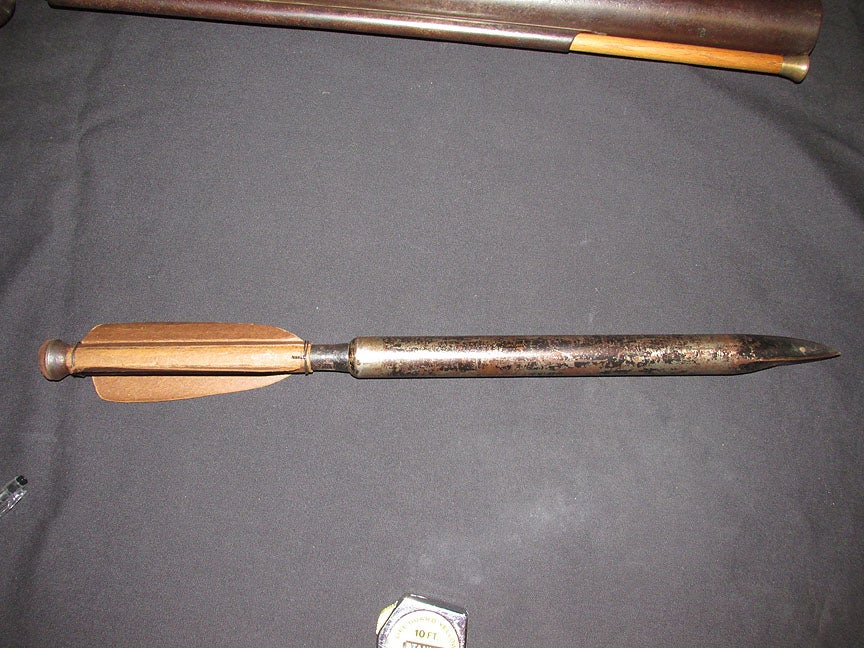
Credit: Vallejo Gallery
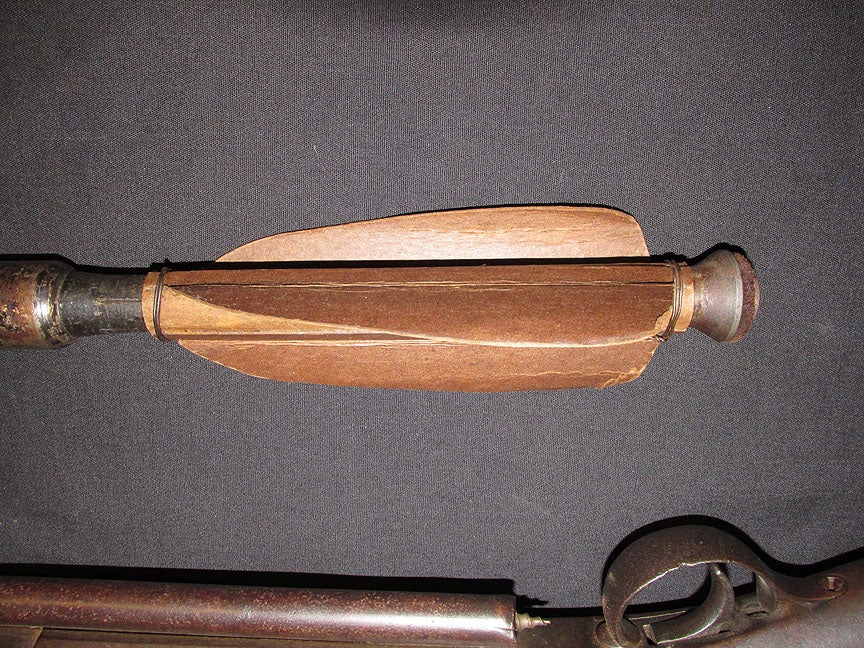
Credit: Vallejo Gallery
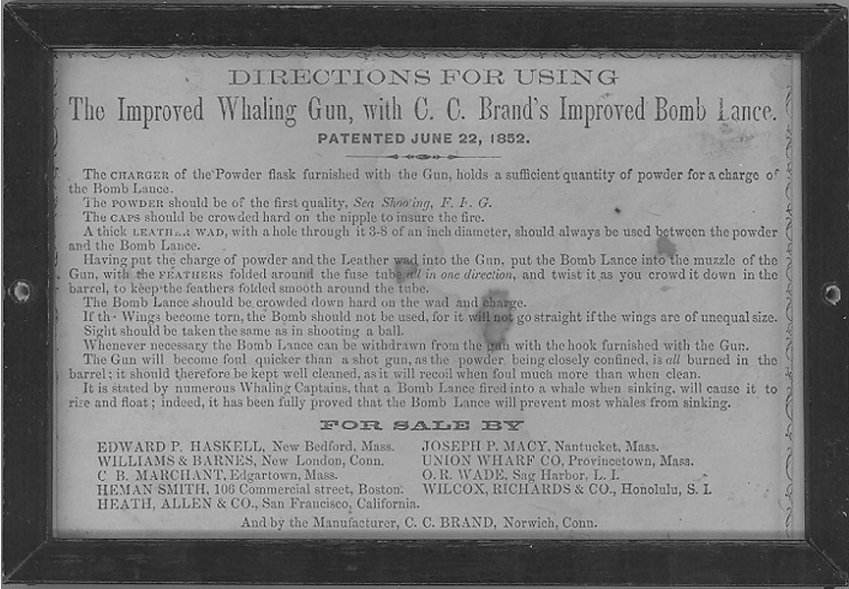
Credit: Vallejo Gallery
Reportedly, they seem to have been quite effective and popular during the mid to late 1800’s and perhaps beyond. However, in the videos I’ve seen recently about current whaling, I haven’t seen any such guns and bomb lances in use, but that doesn’t necessarily mean they’re not. Let me know in the comments below if you’ve ever seen or held a Brand gun or its ammunition!
 Your Privacy Choices
Your Privacy Choices
